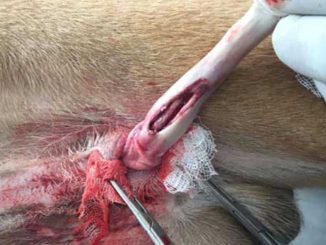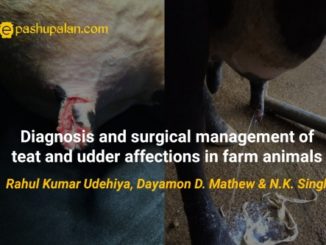Introduction
In India we consider cattle as part of the family and take good care of animal. Unfortunately, the oral hygiene is one of the ignored aspects as far as wellbeing of the animal is considered. Farmers/ owners often come to know about it when it has already caused tremendous stress on the animal and may have started showing its effect on the production and wellbeing. Cattle have 32 permanent teeth with a dental formula of 2(incisors 0/4, premolars 3/3, and molars 3/3). The temporary incisor teeth erupt sequentially at approximately weekly intervals from birth. The three temporary premolar teeth erupt within two to six weeks. The first permanent molar erupts at eight months. The second permanent molar erupts at nine to 12 months, and the third permanent molar and permanent premolars erupt from 24 months. The first (central) pair of permanent incisors erupt at 18 months and are fully in wear by 24 months. The second (medials), third (laterals) and fourth (corners) incisor teeth erupt sequentially at six months’ intervals; 30 month-old cattle having four broad (adult) teeth.
In this article we will consider some very common and important conditions/ ailments associated with oral cavity of the cattle.
Inborn abnormalities
Includes cleft palate (an opening or split in the roof of the mouth), prognathia (an extension or bulging out (protrusion) of the lower jaw (mandible)) and brachygnathia (Abnormal shortness or recession of the mandible) are rare and surgical intervention in livestock is of little help or animal just acclimatize accordingly. Animal with Prognathia and brachygnathia defects can be managed by careful feeding and managemental practice ensuring an adequate concentrate component of the ration to maintain growth rate to slaughter. Calves with severe cleft palate are typically recognized by the presence of milk at the nostrils when sucking and are culled/ euthanized for welfare reasons.
Mild trauma, laceration to fracture
Cattle with lesions of the mouth usually present with profuse salivation, presence to feed between cheeks and teeth. Animal often have poor abdominal fill due to impaired feeding. Lesions affecting the cheek result in obvious firm swellings around cheeks. Infected lesions of the cheek and/or tongue may cause halitosis. Jaw fractures occur most commonly after hits by vehicle, animal fights or occasionally when the animal has its head through a feed barrier. The animal does not feed because of pain and difficulty with masticating food leading to a gaunt appearance. The tongue may passively protrude from the mouth and continuous drooling of salivation is common. There is swelling around the fracture site. Veterinary attention is essential to establish a definitive diagnosis. Mal-alignment of the dental arcade can usually be palpated at the fracture site. The displacement at the fracture site is often slight and best appreciated by running a finger along the lingual aspect of the premolar and molar teeth. The fracture site can be demonstrated radiographically but such examination is not always undertaken in practice. Treatment Slight displacement of the fracture is treated conservatively by isolating the animal and feeding soft/soaked feedstuffs at shoulder height. Prolonged antibiotic therapy may be considered necessary to prevent infection of the healing fracture. Displaced, open and pathological fractures necessitate emergency slaughter for welfare reasons. Jaw fractures can be prevented by careful operation of farm vehicles especially when feeding cattle from elevated central passageways.
Bovine papular stomatitis
Bovine papular stomatitis is caused by a parapoxvirus virus which also causes pseudocowpox. The disease is transmitted and spread in herd by direct contact between calves and/or contaminated feed buckets. The virus enters the animal through abrasions in the mucosa. Calves one- to 12-month-old are most commonly affected. In most of the infected animals clinical signs are few such transient anorexia, salivation, and mild pyrexia. The lesions comprise expanding papular rings on the muzzle, nostrils and in the mouth. No treatment is required as spontaneous recovery occurs within 4-7 days. Disease transmission can be reduced by avoiding group housing and use of shared feeding buckets/teats, and strict hygiene and disinfection of feeding utensils.
Calf Diphtheria
Diphtheria most often occurs as necrotic stomatitis in calves less than three months of age, but usually occurs as necrotic laryngitis in older calves. As in the case previously discussed, necrotic stomatitis caused fever, depression, anorexia, excessive salivation, and a fetid smelling breath. An outbreak of disease in dairy calves is typically traced to unhygienic conditions with dirty feeding equipment. Lesions may also follow trauma to the buccal cavity caused by esophageal feeders used to administer oral electrolyte solutions, and dosing gun injuries. The calf’s lower jaw is wet caused by drooling of saliva with obvious swelling of the cheek. There is halitosis and the rectal temperature may be elevated. Infection may extend to involve the larynx causing frequent harsh coughing and obvious roaring or honking sounds on inspiration. Death may occur in severe cases due to asphyxiation when necrotic debris occludes the windpipe. Calf diphtheria is often treated with daily procaine penicillin by intramuscular injection for 5 to 7 consecutive days as directed by your veterinarian. Veterinary attention is essential when infection causes respiratory distress; relapses are common. Calf diphtheria is prevented by strict hygiene.
Actinobacillosis (wooden tongue)
Actinobacillus lignieresii, is a commensal of the bovine upper respiratory and alimentary tracts which gains entry through breaks in the buccal mucosa causing wooden tongue. Outbreaks of wooden tongue may follow the feeding of hay containing fibrous stalks or thistles. The characteristic lesion is a granuloma of the tongue, with discharge of pus to the exterior. Infection usually begins as an acute inflammation with inability to eat or drink for several days, drooling saliva, rapid loss of condition, painful and swollen tongue with nodules and ulcers. Animals may occasionally die from starvation and thirst in the acute stages of the disease. As the infection becomes chronic, fibrous tissue is deposited and the tongue becomes shrunken and immobile and eating is difficult. Treatment Cattle with wooden tongue should be isolated. Prompt treatment with 5-7 consecutive days’ penicillin and streptomycin combination or potentiated sulphonamide should achieve a good response.
Actinomycosis (Lumpy Jaw)
Infection with the bacterium Actinomyces bovis occasionally causes osteomyelitis in the maxilla (cheek) and mandible (jaw) of adult cattle. The organism may gain entry to the bone associated with permanent molar teeth eruption or traumatic buccal injury. There is marked enlargement of the mandible and often one or more discharging sinuses. Pain and physical deformity cause problems with masticating fibrous food with consequent rapid loss of milk yield and body condition. Sodium iodide is the treatment of choice in ruminants. The goal of treatment for actinomycosis is to kill the bacteria and stop the spread of the lesion. Intravenous sodium iodide (70 mg/kg of a 10%–20% solution) is given once and then repeated several times at 7–10 day intervals. If clinical signs of iodine toxicity develop (including dandruff, diarrhea, anorexia, coughing, and excessive lacrimation), iodine administration should be discontinued or treatments given at greater intervals. Sodium iodide has been shown to be safe for use in pregnant cows and presents little risk of abortion. Concurrent administration of antimicrobials, including penicillin, florfenicol, or oxytetracycline, is recommended.
Conclusion
the most common conditions associated with Buccal cavity of the animals are treatable. Well, intime interventions can reduce the suffering as well as fall in production.
| The content of the articles are accurate and true to the best of the author’s knowledge. It is not meant to substitute for diagnosis, prognosis, treatment, prescription, or formal and individualized advice from a veterinary medical professional. Animals exhibiting signs and symptoms of distress should be seen by a veterinarian immediately. |






Be the first to comment